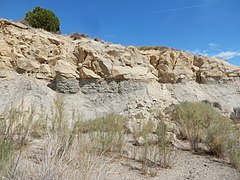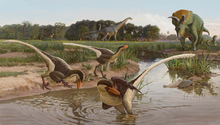Ojo Alamo Formation
| Ojo Alamo Formation | |
|---|---|
| Stratigraphic range: Maastrichtian-Danian ~ | |
 Ojo Alamo Formation in the Bisti/De-Na-Zin Wilderness | |
| Type | Geological formation |
| Sub-units | Naashoibito Member, Kimbeto Member |
| Underlies | Nacimiento Formation |
| Overlies | Kirtland Formation |
| Lithology | |
| Primary | Conglomerate, sandstone, shale |
| Location | |
| Coordinates | 36°19′50″N 108°02′06″W / 36.3305764°N 108.0350723°W |
| Region | San Juan Basin, New Mexico |
| Country | |
| Type section | |
| Named for | Ojo Alamo Spring |
| Named by | B. Brown |
| Year defined | 1910 |
The Ojo Alamo Formation is a geologic formation in New Mexico spanning the Mesozoic/Cenozoic boundary. Non-avian dinosaur fossils have controversially been identified in beds of this formation dating from after the Cretaceous–Paleogene extinction event, but these have been explained as either misidentification of the beds in question or as reworked fossils, fossils eroded from older beds and redeposited in the younger beds.
Description
[edit]The Ojo Alamo Formation is divided into two subunits separated by a large unconformity—a gap in the geologic record. The lower Naashoibito member (sometimes considered part of the Kirtland Formation) was deposited during the Maastrichtian age of the Cretaceous period, specifically between about 69-68 million years ago. It overlies the De-na-zin member of the Kirtland formation, though the two are separated by another large unconformity that spans a period of geologic time equivalent to 73-69 million years ago.[1] All dinosaur fossils probably come from this unit.[2] Although argon dating suggest the naashoibito member would be dated to 66.5 mya. [3] The upper unit of the Ojo Alamo Formation is the Kimbeto Member, which was deposited mainly during the earliest Cenozoic (Danian age of the Paleogene period), between 66 and 64 million years ago.[1]
Fossils
[edit]

Dinosaur remains are among the fossils that have been recovered from the formation, though all dinosaur remains come from the lowest part of the formation, the Naashoibito member (sometimes considered part of the Kirtland Formation, which dates to the late Maastrichtian stage of the Cretaceous period).[4]
Some researchers have claimed to find isolated non-avian dinosaur remains in the younger Kimbeto Member. If this is the case, it would represent the only known instance of a non-avian dinosaur population persisting after the Cretaceous–Paleogene extinction event. However, most scientists consider these to have been stratigraphically misinterpreted or reworked from the older Naashoibito member.[2]
Alamo Wash fauna
[edit]The following species are known to be present in the Naashoibito Member "Alamo Wash Fauna".[5]
Fish
| Genus | Species | Material | Notes | Images |
|---|---|---|---|---|
|
M. sp. |
A single tooth | An anacoracid elasmobranch. A single tooth (NMMNH P-44485), consisting of a six-sided crown with double roots. Only occurrence of the genus in the Naashoibito Member, but miight actually be from the underlying De-na-zin Member of the Kirtland Formation. | ||
|
?S. sp. |
An isolated tooth | An orectolobid elasmobranch. May represent the first and only record of this taxon from the Naashoibito Member. | ||
| Lepisosteidae[5] | Indeterminate | Multiple isolated scales | A gar |
Amphibians
| Genus | Species | Material | Notes | Images |
|---|---|---|---|---|
|
Indeterminate |
An incomplete trunk vertebra | An indeterminate salamander. Tentatively assigned to Batrachosauroididae based on general similarities to Opisthotrition-like specimens. |
Testudines
| Genus | Species | Material | Notes | Images |
|---|---|---|---|---|
|
C. sp. |
Multiple shell fragments | A pleurosternid testudine. Species-level identification is not possible, but similarities have been noted with Compsemys vafer. | ||
|
H. sp. |
A complete plastron and a few fragments | |||
|
cf. P. sp. |
Nearly complete right parietal | A trionychid testudine. Compares readily to Plastomenus thomasi. | ||
|
Indeterminate |
Mostly carapace fragments | An adocid testudine. Among the attributed material is the holotype of Adocus vigoratus, now considered a nomen dubium. | ||
|
B. sp. |
Fragments of carapace and plastron | A nanhsiungchelyid testudine. Previously Basilemys nobilis, it is now considered a nomen dubium which isn't assignable at the species level. | ||
| Paracryptodira[5] | Indeterminate | An incomplete carapace fragment | An indeterminate paracryptodiran. Similar in shell morphology to Compsemys. | |
| Baenidae[5] | Indeterminate | Carapace and skull fragments | An indeterminate baenid. | |
| Trionychidae[5] | Indeterminate | Dozens of specimens | An indeterminate trionychid. A lot of material has been recovered, but it is fragmentary and not able to be defined to the genus level. | |
| Testudinidae[5] | Indeterminate | Indeterminate shell and carapace fragments. | Indeterminate testudine. Not identifiable to any lower taxonomic rank due to their fragmentary nature. |
Squamates
| Genus | Species | Material | Notes | Images |
|---|---|---|---|---|
|
P. sp. |
A jaw fragment and multiple teeth | Fossil material requires proper documentation. | ||
| ?Chamops[5] | ?C. sp. | A tooth | A teiid lizard. The tooth was originally identified as that of a cyprinid fish. Its presence in the Alamo Wash fauna is questionable. |
Crocodylians
| Genus | Species | Material | Notes | Images |
|---|---|---|---|---|
| Brachychampsa[5] | cf. B. sp. | A single tooth | An alligatorid. The tooth was previously attributed to Allognathosuchus. | |
| Crocodylidae[5] | Indeterminate | A mandibular fragment, multiple teeth and osteoderms. | An indeterminate crocodillian of which material has been referred to multiple genera in the past, including Leidyosuchus and Denazinosuchus. |
Dinosaurs
| Genus | Species | Material | Notes | Images |
|---|---|---|---|---|
|
D. notohesperus |
 | |||
|
O. boerei |
Possibly a nomen dubium[8] |  | ||
|
Indeterminate |
||||
|
Indeterminate |
 | |||
|
R. sp. |
 | |||
|
Indeterminate |
 | |||
|
cf. T. sp. |
||||
|
A. sanjuanensis |
 | |||
|
G. mimus |
 | |||
|
Indeterminate |
Noted to be similar to Euoplocephalus and Ankylosaurus |
 | ||
|
Indeterminate |
||||
|
Indeterminate |
||||
|
Indeterminate |
Noted as being similar to Corythosaurus and Hypacrosaurus |
|||
|
Indeterminate |
||||
|
O. fowleri |
 |
Mammals
| Genus | Species | Material | Notes | Images |
|---|---|---|---|---|
|
cf. A. marshi |
||||
|
Indeterminate |
||||
|
E. browni |
||||
|
cf. G. sp. |
||||
|
M. formosa |
||||
|
cf. M. sp. |
||||
|
Indeterminate |
||||
|
cf. Indeterminate |
History of investigation
[edit]The formation was named by Barnum Brown in 1910 for exposures near Ojo Alamo springs in the San Juan Basin.[14] Baltz et al. reassigned the lower beds to the Kirtland Formation in 1966, but this has not been generally accepted.[15]
See also
[edit]References
[edit]- ^ a b Sullivan, R.M., and Lucas, S.G. 2006. "The Kirtlandian land-vertebrate "age" – faunal composition, temporal position and biostratigraphic correlation in the nonmarine Upper Cretaceous of western North America." New Mexico Museum of Natural History and Science, Bulletin 35:7-29.
- ^ a b Sullivan, RM (2003). "No Paleocene dinosaurs in the San Juan Basin, New Mexico". Geological Society of America Abstracts with Programs. 35 (5): 15. Archived from the original on 2011-04-08. Retrieved 2007-07-02.
- ^ Cite error: The named reference
https://pmc.ncbi.nlm.nih.gov/articles/PMC7099077/#CR20was invoked but never defined (see the help page). - ^ Williamson, T.E. and Weil, A. (2008). "Metatherian mammals from the Naashoibito Member, Kirtland Formation, San Juan Basin, New Mexico and their biochronologic and paleobiogeographic significance. Journal of Vertebrate Paleontology, 28: 803-815.
- ^ a b c d e f g h i j k l m n o p q r Jasinski, S. E., Sullivan, R. M., & Lucas, S. G. (2011). Taxonomic composition of the Alamo Wash local fauna from the Upper Cretaceous Ojo Alamo Formation (Naashoibito Member) San Juan Basin, New Mexico. Bulletin, 53, 216-271.
- ^ Jasinski, Steven E.; Sullivan, Robert M.; Dodson, Peter (2020-03-26). "New Dromaeosaurid Dinosaur (Theropoda, Dromaeosauridae) from New Mexico and Biodiversity of Dromaeosaurids at the end of the Cretaceous". Scientific Reports. 10 (5105): 5105. Bibcode:2020NatSR..10.5105J. doi:10.1038/s41598-020-61480-7. PMC 7099077. PMID 32218481.
- ^ Robert M. Sullivan, Steven E. Jasinski and Mark P.A. Van Tomme (2011). "A new caenagnathid Ojoraptorsaurus boerei, n. gen., n. sp. (Dinosauria, Oviraptorosauria), from the Upper Ojo Alamo Formation (Naashoibito Member), San Juan Basin, New Mexico". Fossil Record 3. New Mexico Museum of Natural History and Science Bulletin. 53: 418–428.
- ^ Funston, G. F.; Williamson, T. E.; Brusatte, S. L. (2024). "A caenagnathid tibia (Theropoda: Oviraptorosauria) from the upper Campanian Kirtland Formation of New Mexico". Cretaceous Research (in press). 105856. doi:10.1016/j.cretres.2024.105856.
- ^ Gilmore, Charles W. (1922). "A new sauropod dinosaur from the Ojo Alamo formation of New Mexico (with two plates)" (PDF). Smithsonian Miscellaneous Collections. 72 (14): 1–9. Retrieved 23 October 2020.
- ^ T.L. Ford. (2000). "A review of ankylosaur osteoderms from New Mexico and a preliminary review of ankylosaur armor", In: S. G. Lucas and A. B. Heckert (eds.), Dinosaurs of New Mexico. New Mexico Museum of Natural History and Science Bulletin 17: 157-176
- ^ Jasinski, Steven E.; Sullivan, Robert M.; Lucas, Spencer G.; Spielmann, Justin A. "The first "lambeosaurin" (Dinosauria, Hadrosauridae, Lambeosaurinae) from the Upper Cretaceous Ojo Alamo Formation (Naashoibito Member), San Juan Basin, New Mexico: further implications for the age of the Alamo Wash local fauna". www.researchgate.com. Retrieved 21 August 2016.
- ^ Robert M. Sullivan and Spencer G. Lucas, 2010, "A New Chasmosaurine (Ceratopsidae, Dinosauria) from the Upper Cretaceous Ojo Alamo Formation (Naashoibito Member), San Juan Basin, New Mexico", In: Ryan, M.J., Chinnery-Allgeier, B.J., and Eberth, D.A. (eds.) New Perspectives on Horned Dinosaurs: The Royal Tyrrell Museum Ceratopsian Symposium, Bloomington, Indiana University Press, 656 pp.
- ^ Willamson, Thomas M.; Weil, Anne (12 September 2008). "Metatherian Mammals from the Naashoibito Member, Kirtland Formation, San Juan Basin, New Mexico and Their Biochronologic and Paleobiogeographic Significance". Journal of Vertebrate Paleontology. 28 (3). Taylor & Francis, Ltd.: 803–815. doi:10.1671/0272-4634(2008)28[803:MMFTNM]2.0.CO;2. JSTOR 20491004. S2CID 140555450. Retrieved 19 November 2020.
- ^ Brown, Barnum, 1910, The Cretaceous Ojo Alamo beds of New Mexico with description of the new dinosaur genus Kritosaurus: American Museum of Natural History Bulletin, v. 28, art. 24, p. 267-274.
- ^ Baltz, E.H., Ash, S.R., and Anderson, R.Y., 1966, History of nomenclature and stratigraphy of rocks adjacent to the Cretaceous-Tertiary boundary, western San Juan basin, New Mexico, IN Shorter contributions to general geology, 1965: U.S. Geological Survey Professional Paper, 524-D, p. D1-D23.
Further reading
[edit]- Burns, Michael E. (2008). "Taxonomic utility of ankylosaur (Dinosauria, Ornithischia) osteoderms: Glyptodontopelta mimus Ford, 2000: a test case". Journal of Vertebrate Paleontology. 28 (4): 1102–1109. Bibcode:2008JVPal..28.1102B. doi:10.1671/0272-4634-28.4.1102. S2CID 140672072.
